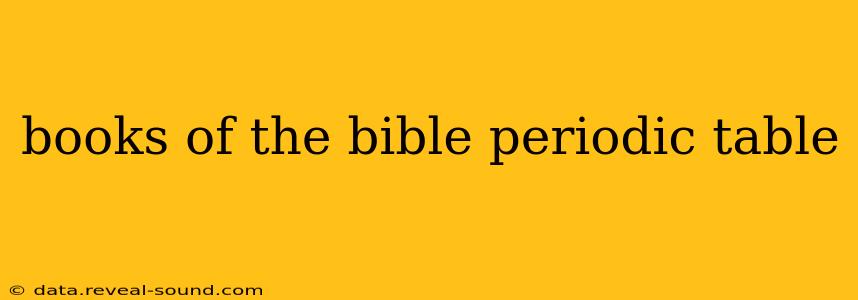The Bible, a collection of sacred texts for Christians and Jews, comprises many books, each with its unique message and purpose. Organizing these books can be challenging, but visualizing them using a periodic table-like structure can offer a novel and engaging way to understand their relationships and key themes. While a true "periodic table" in the scientific sense is impossible due to the theological and narrative differences between biblical books, we can create a thematic organization that highlights key similarities and differences.
This "periodic table" will not be based on atomic numbers or chemical properties, but instead will group books based on genre, historical period, and theological emphasis. This approach allows for a deeper understanding of the Bible's overall structure and narrative arc. Think of it as a tool for exploring the diverse literary landscape of the Bible, rather than a rigid, scientifically accurate classification.
Categorizing the Books of the Bible: A Thematic Approach
Instead of strict columns and rows, we'll focus on broad categories, recognizing that some books may overlap:
Group 1: The Pentateuch (Law)
- Genesis: Creation, the patriarchs, and the covenant with Abraham.
- Exodus: The liberation from Egypt and the giving of the Law at Sinai.
- Leviticus: Priestly laws and rituals.
- Numbers: The wilderness journey and census of the Israelites.
- Deuteronomy: Reiteration of the Law and Moses' farewell speeches.
This group lays the foundational legal and narrative framework for the rest of the Bible.
Group 2: Historical Books
- Joshua: Conquest of Canaan.
- Judges: Period of Israelite judges and cycles of oppression and liberation.
- Ruth: Story of Ruth, a Moabite woman who becomes part of Israel's lineage.
- 1 & 2 Samuel: Reigns of Saul, David, and Solomon.
- 1 & 2 Kings: History of the divided kingdom of Israel and Judah.
- 1 & 2 Chronicles: Parallel accounts emphasizing the lineage of David and the temple.
- Ezra & Nehemiah: Return from exile and rebuilding of Jerusalem.
- Esther: Story of Esther, a Jewish queen who saves her people from annihilation.
These books chronicle the history of Israel, highlighting both triumphs and failures, and providing context for the later prophetic and wisdom literature.
Group 3: Poetry & Wisdom Literature
- Job: A story exploring themes of suffering, justice, and faith.
- Psalms: Collection of prayers, hymns, and songs of praise.
- Proverbs: Collection of wise sayings and practical advice.
- Ecclesiastes: Reflections on the meaning of life and the futility of worldly pursuits.
- Song of Solomon: A love poem, often interpreted allegorically.
This group focuses on expressing emotions, exploring life's complexities, and offering guidance for living a virtuous life.
Group 4: Major Prophets
- Isaiah: Prophetic messages addressing the kingdom of Judah.
- Jeremiah: Messages of judgment and hope for Judah during a time of crisis.
- Lamentations: Mourning the destruction of Jerusalem.
- Ezekiel: Visionary prophecies and restoration themes.
- Daniel: Prophetic visions and stories set during the Babylonian exile.
These prophets delivered God's message to the people during times of upheaval and offered both warnings and promises.
Group 5: Minor Prophets
This group comprises twelve shorter prophetic books, each with its own distinct message and focus. Their messages frequently overlap and address similar concerns.
Group 6: The Gospels (New Testament)
- Matthew: Emphasizes Jesus' kingship and fulfillment of Old Testament prophecies.
- Mark: Presents Jesus as a powerful miracle worker and suffering servant.
- Luke: Highlights Jesus' compassion and concern for the marginalized.
- John: Focuses on Jesus' divinity and relationship with God.
These four Gospels provide different perspectives on the life, ministry, death, and resurrection of Jesus.
Group 7: Acts of the Apostles
This book recounts the early history of the Christian church and the spread of the Gospel after Jesus' ascension.
Group 8: Pauline Epistles (Letters of Paul)
This group includes thirteen letters attributed to the Apostle Paul, each addressed to different churches or individuals, offering instruction, encouragement, and theological insights.
Group 9: General Epistles
These letters, attributed to various authors, address a wider audience, covering various theological and practical topics. They offer guidance on Christian living and faith.
Group 10: Revelation
This apocalyptic book presents visions of the future and the ultimate triumph of God.
Frequently Asked Questions (FAQs)
What is the best way to read the Bible?
There's no single "best" way. Many people begin with the Gospels (Matthew, Mark, Luke, John) to learn about Jesus, then explore the historical books and the letters of Paul. Others prefer a chronological approach, starting with Genesis and moving forward. The key is to find a method that works for you and allows you to engage with the text.
How are the books of the Bible organized?
The Bible is divided into two major sections: the Old Testament and the New Testament. Within each section, the books are grouped thematically (as described above), though the order isn't strictly chronological or logical in all cases. The order evolved over centuries.
What is the difference between the Old and New Testaments?
The Old Testament primarily covers the history of Israel, God's covenant with his people, and the prophecies concerning the coming Messiah. The New Testament focuses on the life, teachings, death, and resurrection of Jesus Christ, the establishment of the early church, and the spread of Christianity.
What are the different genres of literature in the Bible?
The Bible includes a wide variety of genres, including historical narratives, law codes, poetry, prophecy, wisdom literature, parables, and apocalyptic writing. Understanding the genre is crucial to interpreting the text correctly.
This "periodic table" approach is just one way to organize and understand the books of the Bible. The beauty of the Bible lies in its depth and complexity, and there is always more to discover and explore. Further research and study will provide even greater insights into this fascinating collection of ancient texts.
